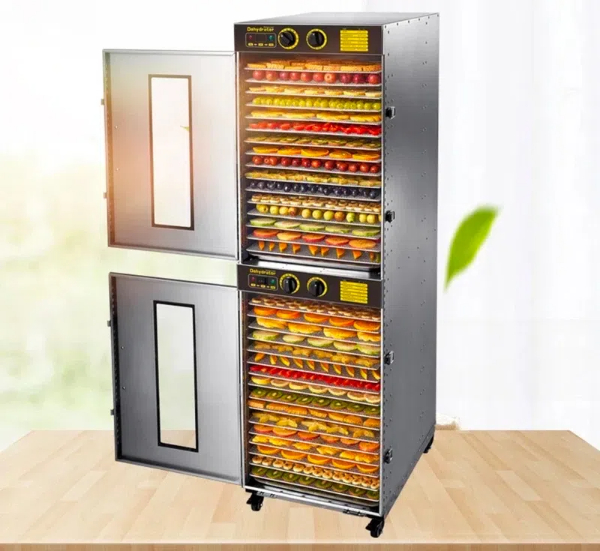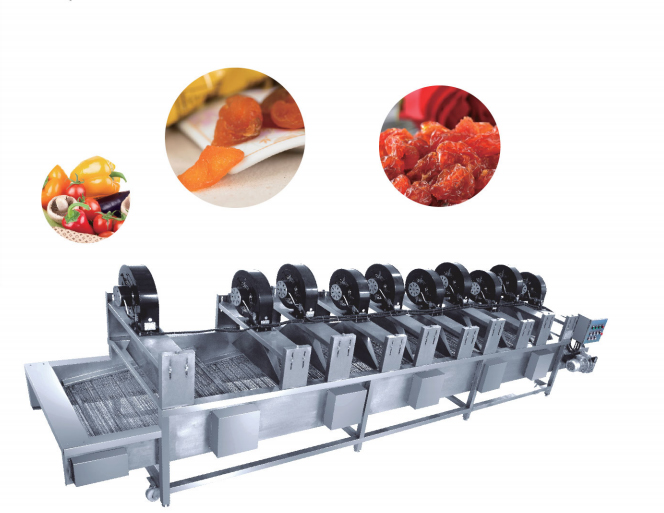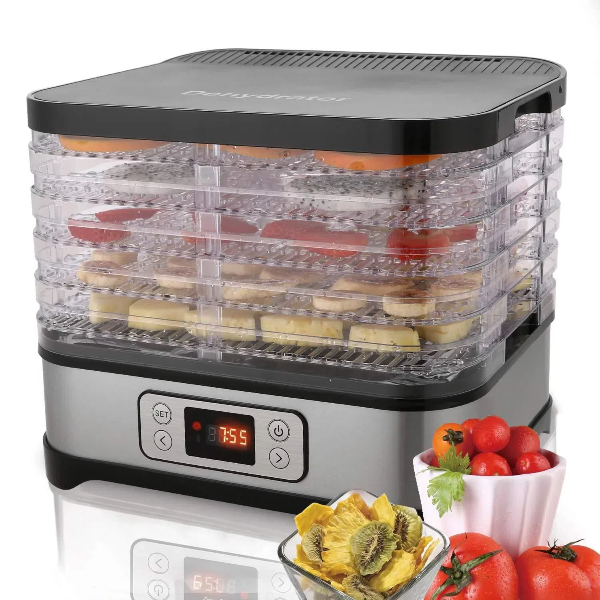
Content Menu
● Introduction to Food Drying Machines
● What is a Food Drying Machine?
● Types of Food Drying Machines
>> 1. Commercial Food Dehydrators
>> 2. Industrial Fruit Dryers
>> 3. Stainless Steel Food Drying Machines
>> 4. Multi-Tray Food Dryers
● Benefits of Using Food Drying Machines
>> 1. Extended Food Shelf Life
>> 2. Preservation of Nutrients
>> 3. Space-Saving Food Storage
>> 4. Cost-Effective Food Preservation
● Choosing the Right Food Drying Machine
>> 1. Capacity
>> 2. Temperature Control
>> 3. Airflow Design
>> 4. Material and Construction
>> 5. Energy Efficiency
● Popular Uses for Food Drying Machines
>> 1. Fruit Dehydration
>> 2. Vegetable Dehydration
>> 3. Meat Jerky Production
>> 4. Herb Drying
● Maintenance and Care of Food Drying Machines
● Innovations in Food Drying Technology
● Conclusion
● Frequently Asked Questions
>> 1. What types of food can I dry in a food drying machine?
>> 2. How long does it take to dry food in a dehydrator?
>> 3. Are food drying machines energy-efficient?
>> 4. How do I clean my food drying machine?
>> 5. Can I use a food drying machine for commercial purposes?
Introduction to Food Drying Machines
In today's fast-paced world, preserving food has become more important than ever. Whether you're a home cook looking to extend the life of your garden's bounty or a business owner seeking to expand your product line, food drying machines offer an excellent solution. These versatile appliances, also known as food dehydrators, have revolutionized the way we preserve fruits, vegetables, meats, and herbs. In this comprehensive guide, we'll explore the world of food drying machines, their benefits, types, and how to choose the right one for your needs.
What is a Food Drying Machine?
A food drying machine, or food dehydrator, is an appliance designed to remove moisture from food items. By circulating warm air over the food, these machines slowly evaporate water content, effectively preserving the food while retaining most of its nutritional value and flavor. From small countertop units for home use to large industrial systems, food drying machines come in various sizes and capacities to suit different needs.
Types of Food Drying Machines
1. Commercial Food Dehydrators
Commercial food dehydrators are designed for small to medium-sized businesses that require larger drying capacities. These machines often feature multiple trays, adjustable temperature controls, and efficient airflow systems. They're perfect for restaurants, small-scale food producers, and farmers' market vendors looking to create dried fruits, vegetables, or jerky.
2. Industrial Fruit Dryers
For large-scale operations, industrial fruit dryers offer high-capacity solutions. These machines are capable of processing large quantities of fruits and vegetables simultaneously. They often incorporate advanced features like programmable drying cycles, humidity controls, and energy-efficient designs.
3. Stainless Steel Food Drying Machines
Stainless steel food drying machines are popular in both commercial and industrial settings due to their durability and ease of cleaning. These machines resist corrosion and can withstand frequent use, making them ideal for busy kitchens and food processing facilities.
4. Multi-Tray Food Dryers
Multi-tray food dryers are versatile options that allow users to dry different types of food simultaneously. With adjustable trays, these machines can accommodate various food sizes and thicknesses. They're excellent for home use or small businesses that need flexibility in their drying processes.

Benefits of Using Food Drying Machines
1. Extended Food Shelf Life
One of the primary advantages of using a food drying machine is the significant extension of food shelf life. By removing moisture, these machines create an environment inhospitable to bacteria and mold growth, allowing dried foods to last for months or even years when properly stored.
2. Preservation of Nutrients
Unlike some other preservation methods, food drying machines help retain most of the nutritional value of the original food. The gentle drying process preserves vitamins, minerals, and enzymes, making dried foods a healthy snack or ingredient option.
3. Space-Saving Food Storage
Dried foods take up significantly less space than their fresh counterparts. This makes them ideal for those with limited storage space or for outdoor enthusiasts looking for lightweight, nutrient-dense food options.
4. Cost-Effective Food Preservation
Investing in a food drying machine can lead to significant cost savings over time. By purchasing produce in bulk during peak season and drying it for later use, you can enjoy your favorite fruits and vegetables year-round without paying premium prices during off-seasons.
Choosing the Right Food Drying Machine
When selecting a food drying machine, consider the following factors:
1. Capacity
Determine how much food you plan to dry regularly. For home use, a small to medium-sized dehydrator may suffice. However, if you're running a business or have a large garden, you might need a commercial or industrial-sized machine.
2. Temperature Control
Look for a food drying machine with adjustable temperature settings. Different foods require different drying temperatures, so having this control allows for more versatility in what you can dry.
3. Airflow Design
Efficient airflow is crucial for even drying. Some machines feature horizontal airflow, which is generally more effective than vertical airflow systems.
4. Material and Construction
Stainless steel food drying machines are durable and easy to clean, making them a popular choice for both home and commercial use. However, there are also high-quality plastic options available for home users.
5. Energy Efficiency
Consider the energy consumption of the machine, especially if you plan to use it frequently. Some modern food drying machines come with energy-saving features that can help reduce operating costs.

Popular Uses for Food Drying Machines
1. Fruit Dehydration
Creating dried fruits is one of the most common uses for food drying machines. From apple chips to dried berries, the possibilities are endless. Dried fruits make excellent snacks and can be used in baking or as toppings for cereals and yogurt.
2. Vegetable Dehydration
Drying vegetables is an excellent way to preserve your garden's harvest or take advantage of seasonal produce. Dried vegetables can be rehydrated for use in soups and stews or enjoyed as crispy snacks.
3. Meat Jerky Production
For meat lovers, food drying machines offer the perfect way to create homemade jerky. This protein-rich snack is easy to make and can be customized with various marinades and seasonings.
4. Herb Drying
Preserve the flavors of fresh herbs by drying them in a food dehydrator. Dried herbs retain their potency and can be stored for extended periods, ensuring you always have your favorite seasonings on hand.
Maintenance and Care of Food Drying Machines
To ensure the longevity and optimal performance of your food drying machine, follow these maintenance tips:
1. Clean the trays and interior after each use to prevent cross-contamination and buildup of food residue.
2. Check and clean air filters regularly to maintain proper airflow.
3. Inspect the heating element and fan periodically for any signs of wear or damage.
4. Store the machine in a clean, dry place when not in use.
5. Follow the manufacturer's guidelines for any specific maintenance requirements.
Innovations in Food Drying Technology
The food drying industry continues to evolve, with new technologies emerging to improve efficiency and product quality. Some recent innovations include:
1. Smart controls and mobile app integration for remote monitoring and control.
2. Improved energy efficiency through advanced heat pump systems.
3. Hybrid drying technologies that combine different drying methods for optimal results.
4. Enhanced sanitation features to meet stringent food safety standards.
Conclusion
Food drying machines have become indispensable tools for both home cooks and food industry professionals. By offering a simple and effective way to preserve food, these appliances help reduce waste, save money, and provide healthy snack options. Whether you're looking for a small electric food dehydrator for your kitchen or a large-scale industrial food drying system for your business, there's a solution out there to meet your needs.
As the demand for preserved foods continues to grow, the market for food drying machines is expected to expand. With ongoing technological advancements, we can anticipate even more efficient and user-friendly machines in the future. By investing in a quality food drying machine, you're not just purchasing an appliance – you're opening up a world of culinary possibilities and embracing a sustainable approach to food preservation.

Frequently Asked Questions
1. What types of food can I dry in a food drying machine?
Answer: Food drying machines are versatile and can be used to dry a wide variety of foods, including fruits, vegetables, meats, herbs, and even flowers. Some popular items include apples, bananas, tomatoes, beef jerky, and basil.
2. How long does it take to dry food in a dehydrator?
Answer: The drying time can vary depending on the type of food, its moisture content, and the specific machine you're using. On average, fruits can take 6-12 hours, vegetables 4-8 hours, and meats 4-12 hours. Always refer to your machine's manual and recipes for specific guidance.
3. Are food drying machines energy-efficient?
Answer: Many modern food drying machines are designed with energy efficiency in mind. While they do consume electricity during operation, they generally use less energy than ovens and can process large quantities of food at once, making them relatively efficient for food preservation.
4. How do I clean my food drying machine?
Answer: Most food drying machines have removable trays that can be washed with warm, soapy water. The interior of the machine can be wiped down with a damp cloth. Always unplug the machine before cleaning and avoid getting water on electrical components. Refer to your machine's manual for specific cleaning instructions.
5. Can I use a food drying machine for commercial purposes?
Answer: Yes, there are food drying machines specifically designed for commercial and industrial use. These machines typically have larger capacities, more robust construction, and advanced features to meet the demands of commercial food production. Be sure to choose a machine that complies with local food safety regulations if you plan to sell dried food products.












